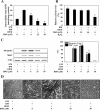Endogenous hydrogen peroxide regulates glutathione redox via nuclear factor erythroid 2-related factor 2 downstream of phosphatidylinositol 3-kinase during muscle differentiation
- PMID: 18458092
- PMCID: PMC2408414
- DOI: 10.2353/ajpath.2008.070429
Endogenous hydrogen peroxide regulates glutathione redox via nuclear factor erythroid 2-related factor 2 downstream of phosphatidylinositol 3-kinase during muscle differentiation
Abstract
We reported previously that endogenous reactive oxygen species (ROS) function as myogenic signaling molecules. It has also been determined that excess ROS induce electrophile-response element (EpRE)-driven gene expression via activation of nuclear factor erythroid 2-related factor 2 (Nrf2). Nonetheless, the relationship between the metabolism of ROS (eg, H(2)O(2)) through glutathione (GSH) up-regulation, GSH-dependent reduction of H(2)O(2), and Nrf2-dependent gene regulation is not well established. Therefore, we attempted to determine whether H(2)O(2) controls the intracellular GSH redox state via the Nrf2-glutamate-cysteine ligase (GCL)/glutathione reductase (GR)-GSH signaling pathway. In our experiments, enhanced H(2)O(2) generation was accompanied by an increase in both total GSH levels and the GSH/GSSG ratio during muscle differentiation. Both GCL and GR transcriptional expression levels were markedly increased during muscle differentiation but reduced by catalase treatment. Nrf2 protein expression and nuclear translocation increased during myogenesis. The inhibition of GCL, GR, and Nrf2 both by inhibitors and by RNA interference blocked muscle differentiation. Phosphatidylinositol 3-kinase regulated the expression of the GCL C (a catalytic subunit) and GR genes via the induction of Nrf2 nuclear translocation and expression. In conclusion, endogenous H(2)O(2) generated during muscle differentiation not only functions as a signaling molecule, but also regulates the GSH redox state via activation of the Nrf2-GCL/GR-GSH signaling pathway downstream of phosphatidylinositol 3-kinase.
Figures








Similar articles
-
Multidrug resistance-associated protein 1 mediates 15-deoxy-Δ(12,14)-prostaglandin J2-induced expression of glutamate cysteine ligase expression via Nrf2 signaling in human breast cancer cells.Chem Res Toxicol. 2011 Aug 15;24(8):1231-41. doi: 10.1021/tx200090n. Epub 2011 Jul 25. Chem Res Toxicol. 2011. PMID: 21728338
-
Trichostatin A inhibits transforming growth factor-β-induced reactive oxygen species accumulation and myofibroblast differentiation via enhanced NF-E2-related factor 2-antioxidant response element signaling.Mol Pharmacol. 2013 Mar;83(3):671-80. doi: 10.1124/mol.112.081059. Epub 2013 Jan 2. Mol Pharmacol. 2013. PMID: 23284002
-
Nrf2 deficiency induces oxidative stress and promotes RANKL-induced osteoclast differentiation.Free Radic Biol Med. 2013 Dec;65:789-799. doi: 10.1016/j.freeradbiomed.2013.08.005. Epub 2013 Aug 14. Free Radic Biol Med. 2013. PMID: 23954472
-
Mechanisms underlying Nrf2 nuclear translocation by non-lethal levels of hydrogen peroxide: p38 MAPK-dependent neutral sphingomyelinase2 membrane trafficking and ceramide/PKCζ/CK2 signaling.Free Radic Biol Med. 2022 Oct;191:191-202. doi: 10.1016/j.freeradbiomed.2022.08.036. Epub 2022 Sep 3. Free Radic Biol Med. 2022. PMID: 36064071 Review.
-
Nrf2 mediates redox adaptations to exercise.Redox Biol. 2016 Dec;10:191-199. doi: 10.1016/j.redox.2016.10.003. Epub 2016 Oct 14. Redox Biol. 2016. PMID: 27770706 Free PMC article. Review.
Cited by
-
Identification of a Sesquiterpene Lactone from Arctium lappa Leaves with Antioxidant Activity in Primary Human Muscle Cells.Molecules. 2021 Mar 2;26(5):1328. doi: 10.3390/molecules26051328. Molecules. 2021. PMID: 33801315 Free PMC article.
-
Mitochondrial H2O2 generated from electron transport chain complex I stimulates muscle differentiation.Cell Res. 2011 May;21(5):817-34. doi: 10.1038/cr.2011.55. Epub 2011 Mar 29. Cell Res. 2011. PMID: 21445095 Free PMC article.
-
Assessment of reference genes for real-time quantitative PCR gene expression normalization during C2C12 and H9c2 skeletal muscle differentiation.Mol Biotechnol. 2014 Apr;56(4):329-39. doi: 10.1007/s12033-013-9712-2. Mol Biotechnol. 2014. PMID: 24146429
-
SOD2 and the Mitochondrial UPR: Partners Regulating Cellular Phenotypic Transitions.Trends Biochem Sci. 2016 Jul;41(7):568-577. doi: 10.1016/j.tibs.2016.04.004. Epub 2016 May 11. Trends Biochem Sci. 2016. PMID: 27180143 Free PMC article.
-
Probiotics prevent intestinal barrier dysfunction in acute pancreatitis in rats via induction of ileal mucosal glutathione biosynthesis.PLoS One. 2009;4(2):e4512. doi: 10.1371/journal.pone.0004512. Epub 2009 Feb 18. PLoS One. 2009. PMID: 19223985 Free PMC article.
References
-
- Lynch GS, Schertzer JD, Ryall JG. Therapeutic approaches for muscle wasting disorders. Pharmacol Ther. 2007;113:461–487. - PubMed
-
- Seale P, Rudnicki MA. A new look at the origin, function, and “stem-cell” status of muscle satellite cells. Dev Biol. 2000;218:115–124. - PubMed
-
- Lim MJ, Choi KJ, Ding Y, Kim JH, Kim BS, Kim YH, Lee J, Choe W, Kang I, Ha J, Yoon KS, Kim SS. RhoA/Rho kinase blocks muscle differentiation via serine phosphorylation of insulin receptor substrate-1 and -2. Mol Endocrinol. 2007;21:2282–2293. - PubMed
-
- Latres E, Amini AR, Amini AA, Griffiths J, Martin FJ, Wei Y, Lin HC, Yancopoulos GD, Glass DJ. Insulin-like growth factor-1 (IGF-1) inversely regulates atrophy-induced genes via the phosphatidylinositol 3-kinase/Akt/mammalian target of rapamycin (PI3K/Akt/mTOR) pathway. J Biol Chem. 2005;280:2737–2744. - PubMed
Publication types
MeSH terms
Substances
Grants and funding
LinkOut - more resources
Full Text Sources
Other Literature Sources

